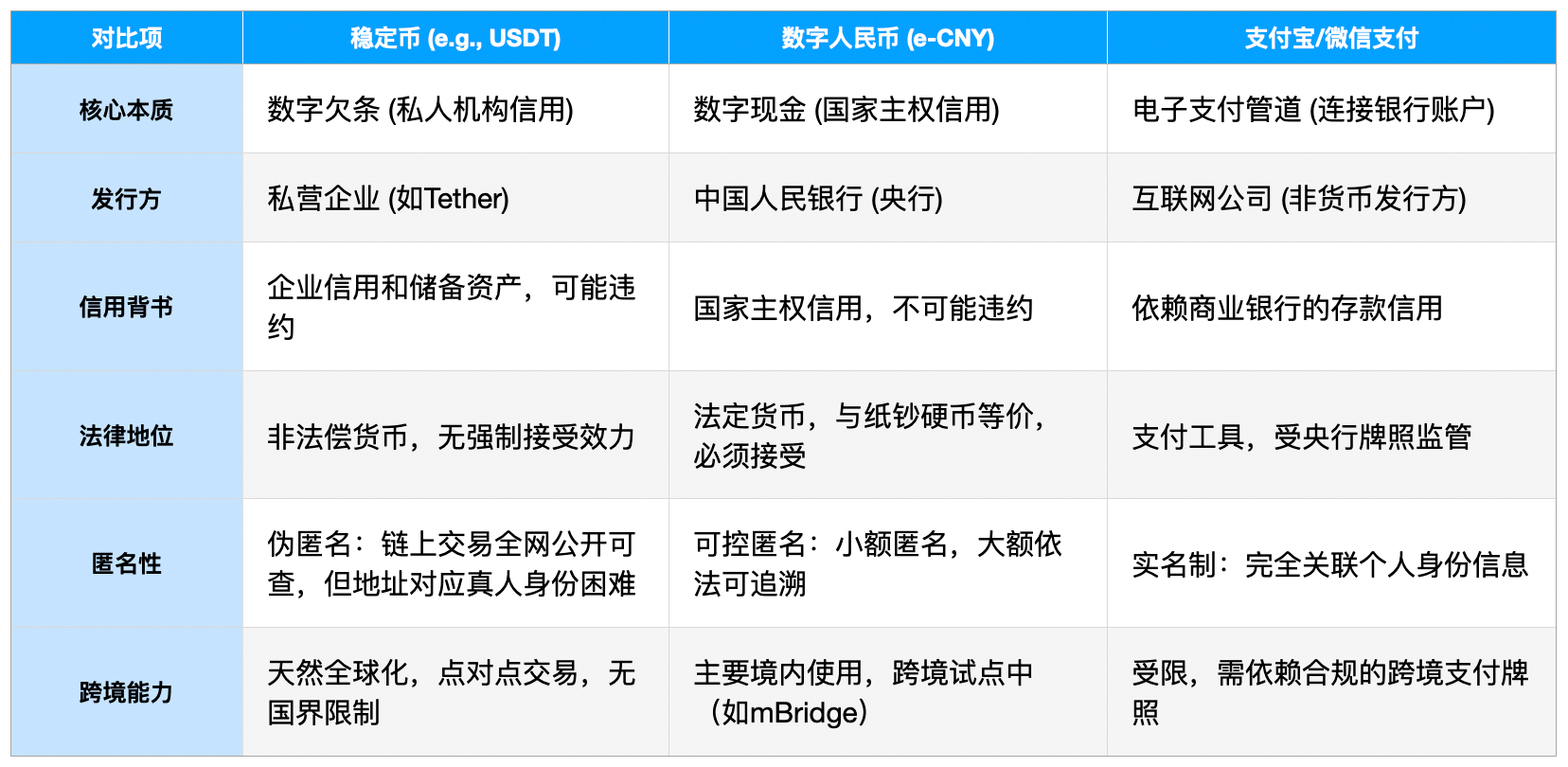Author: Yokiiiya
I recently talked with many friends about stablecoins and found that everyone is both curious and has many questions. For example, is it really money? How is it different from WeChat Pay? Why does it seem like everyone is talking about it overnight?
I personally think we can set aside the complex technical jargon and dizzying financial models, and return to the most essential level to try to sort out a few core logics of stablecoins. Everyone is welcome to discuss and exchange ideas.
The Essence of Stablecoins is "Digital IOUs"
This is the foundation for understanding everything and is the concept that needs to be distinguished most clearly.
Stablecoins are essentially "certificates," not "currency," which means they are on-chain digital certificates pegged to fiat currencies (like the US dollar) or physical assets (like gold). Their value entirely depends on the reserve assets and credit of the issuing institution, and they do not possess the credit-creating function of money.
Imagine this: you give the owner of the convenience store downstairs 100 yuan in cash, and he doesn't have change, so he writes you a stamped "IOU," which you can exchange for two bottles of cola tomorrow. This "IOU" is recognized by everyone in your neighborhood and can even be exchanged directly for other goods.

Stablecoins are this "digital IOU."
Who wrote the IOU?
- Not the state, but private companies like Tether and Circle.
What gives it value?
- The company claims it has sufficient US dollars (or government bonds) deposited in the bank as collateral, 1 USDT ≈ 1 US dollar.
Where does it circulate?
- On the blockchain (a global, public digital ledger), so it can be instantly transmitted to any corner of the world.
So, when you hold 100 USDT, what you actually have is not 100 US dollars, but an "IOU" issued by Tether, promising that you can exchange it for 100 US dollars at any time. This "IOU" is made into the form of a digital token that can circulate efficiently on the blockchain. This is its most core essence.
Stablecoins vs. Digital Renminbi vs. Alipay/WeChat Pay
This is the part that people find most confusing, so let's explain it with a comparison table:

To summarize:
The digital renminbi can be understood as cash stored in your digital wallet; it is money itself.
Alipay can be understood as the wallet itself, which contains money withdrawn from the bank (deposits), and it is responsible for helping us complete payment actions.
Stablecoins can be understood as an IOU written by someone else, which can be frequently traded and transferred within a specific circle (blockchain network). Everyone recognizes that it can ultimately be exchanged for real money, but it is not money itself.
Why Stablecoins Are Popular
First and foremost, stablecoins solve a major global pain point: slow and expensive cross-border transfers.
Traditional model (SWIFT): It's like sending a physical letter internationally. Sending from China to the US requires first giving it to the Chinese postal service (your bank), which then finds an international courier (the SWIFT network), the courier delivers it to the US postal service (the correspondent bank), and finally, it reaches your friend. The process is long, with multiple fees, taking several days, and the handling fee can be hundreds of yuan.
Stablecoin model: It's like sending a WeChat message. You are in China, your friend is in the US, you click to transfer, and his phone "ding" receives it. It operates 24/7, arrives within minutes, and has very low fees (possibly just a few cents). This is revolutionary for those engaged in foreign trade or migrant workers sending money home.
Many traditional payment methods, especially cross-border ones, need to be "reconstructed" using stablecoins, presenting numerous opportunities.

Secondly, based on the characteristics of blockchain itself, stablecoins have programmability and high efficiency: based on smart contracts, they can achieve "payment upon payment" (Payment vs. Payment, PvP), greatly enhancing financial settlement efficiency and reducing counterparty risk.
Traditional money, such as cash or deposits in a bank account, is "static." Its flow entirely depends on manual operations and instructions from third-party institutions. In contrast, the essence of stablecoins is based on blockchain code (tokens). This means that their behavioral rules can be pre-set through smart contracts.
Because all rules are written in code on the chain, any digital system can connect by calling interfaces, without needing to negotiate, connect, and test with each traditional financial institution. This "plug-and-play" feature can indeed ignite innovation, just as open internet protocols have spawned countless applications.
This programmability brings several revolutionary features:
Conditional payments: It can achieve "cash on delivery," "payment upon presentation of the bill," and "performance-based payments," significantly reducing trust costs and friction in transactions.
Automation: Repetitive financial operations like salary payments, rent payments, and investment contributions can be fully automated.
Composability: Stablecoins can be freely combined with other smart contracts (like loans, insurance, trading agreements) like Lego blocks, creating entirely new financial products.
RWA (Real World Asset tokenization) utilizes the above characteristics of stablecoins to "tokenize" real assets such as real estate, company equity, and government bonds (turning them into digital certificates on the blockchain), using stablecoins as a natural unit of pricing, trading, and settlement.
Risks of Stablecoins

The risks of stablecoins stem from the "transfer of trust." In traditional finance, we trust sovereign credit and regulated financial institutions (like banks). When using stablecoins, we transfer our trust to:
1. The integrity and transparency of the issuer (Is it really fully collateralized?)
2. The security of the underlying code (Are there vulnerabilities in the smart contract?)
3. Regulatory uncertainty (Will it be banned tomorrow?)
Related risks include:
Decoupling risk: This is the most fundamental risk. If the issuing institution is under-reserved, misappropriates funds, or goes bankrupt, the stablecoin cannot be redeemed 1:1, leading to "decoupling," and holders may lose their entire investment (like the UST collapse incident).
Systemic financial risk:
To banks: It may lead to "deposit disintermediation," with funds flowing out of the traditional banking system, affecting banks' credit capacity. A "run" on custodial deposits could trigger a liquidity crisis.
To the market: Large-scale redemptions of stablecoins may force issuers to sell their reserve assets (like short-term US Treasury bonds), potentially amplifying financial market volatility.
Regulatory arbitrage and illegal activities: Its pseudo-anonymity and cross-border characteristics make it easy to become a tool for money laundering, terrorist financing, and evading capital controls, posing a significant challenge to the existing financial regulatory system.
These potential risks of stablecoins directly touch upon the fundamentals of the modern financial system. This is also the core reason why global regulatory agencies are so tense and on high alert regarding stablecoins.
However, the purpose of regulation is not to stifle innovation but to attempt to find a difficult balance between "encouraging financial innovation" and "maintaining financial stability":
Set clear "traffic rules": Allow the car (innovation) to run faster, but not to run red lights or cause accidents.
Equip this "fast car" with brakes and airbags: Ensure that it can protect the people inside and pedestrians in case of loss of control.
Ensure the driver (issuer) has a license and is not drunk: Guarantee that they are qualified and follow the rules.
Therefore, a mature and clear regulatory framework is not a shackle but the best "safety certification" and "entry ticket" for the long-term healthy development of the stablecoin industry. It can weed out poor players, give confidence to compliant ones, and ultimately attract large-scale funds from the traditional world to enter safely.
Differences in Pathways Between China and the US: Completely Different Strategic Motivations
United States: "Leveraging Private for Public," Consolidating Dollar Hegemony
Motivation: By issuing stablecoins pegged to the dollar through the private sector, it aims to secure a position in the global digital economy and new financial infrastructure, making the dollar the base currency of the on-chain world to counter the trend of "de-dollarization." This is a strategy for "external circulation" of the dollar.
Attitude: Actively legislate and regulate, incorporating it into the traditional financial regulatory system (like MSB licenses), while explicitly prohibiting or delaying central bank digital currency (CBDC) to avoid competition with the private sector and impact on the banking system.

China: "Sovereignty First, Cautious Exploration"
Motivation: Everything is predicated on maintaining financial stability and monetary sovereignty. Any private stablecoin is strictly prohibited domestically to prevent it from impacting the digital renminbi and the existing financial system.
Exploration: Support the development of stablecoins in Hong Kong, using it as a "testing ground" to explore the application of offshore renminbi stablecoins, serving the strategy of renminbi internationalization, and acting as a supplementary tool for the digital renminbi in cross-border scenarios, rather than a substitute.
免责声明:本文章仅代表作者个人观点,不代表本平台的立场和观点。本文章仅供信息分享,不构成对任何人的任何投资建议。用户与作者之间的任何争议,与本平台无关。如网页中刊载的文章或图片涉及侵权,请提供相关的权利证明和身份证明发送邮件到support@aicoin.com,本平台相关工作人员将会进行核查。




